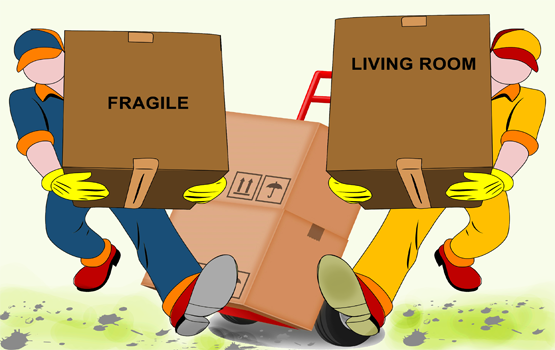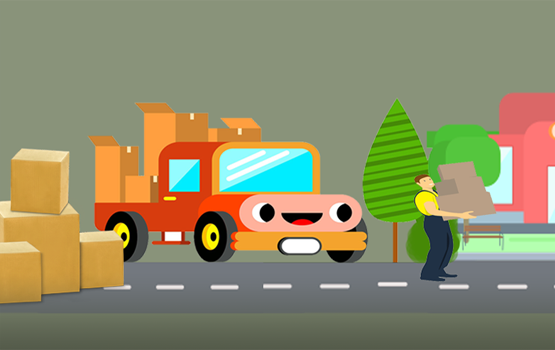Packing Tips
Packing can be overwhelming, so get organized and start packing early. Packing little by little is much easier and far less stressful than trying to deal with it in one or two days. So, start packing seasonal items and other stuff you know you won't be using as early as possible.
Prior to moving, organize your belongings and get rid of all items you no longer use. You can sell unwanted items on yard or garage sale or donate them, just make sure you eliminate them from your home before you start packing.
Label all your packed boxes accurately and clearly (preferably on all sides not on the top), so you can easily find what you need in a stack. To make unpacking easier, avoid mixing items from different rooms in the same box.
Mark your boxes with labels for where you want them to go. It's also a good idea to stack and load boxes from (or for) the same rooms together. That way they will end up in the correct space from the get-go which makes unpacking everything much more organized and faster.
If you have time, you can take your box labeling a step further by creating a box number system. As you pack each box, write a list of the contents of each box (with the number and appropriate room listed), then give the box and list same number and room name. You can use phone app or computer for creating lists. That way you will know the total number of boxes for each room you are moving and you can go through your numbered lists to find any item you want.
Make sure your moving boxes are closed and taped properly. Open boxes take more space and are more difficult to handle.
Separately pack all your important documents like health records, passports, family records, insurance information, financial documents, school documents and related important stuff and take them with you to be safe, easily accessible and easy to find.
Make sure your valuables are packed carefully. They should be carried personally or special arrangements should be made for their transport.
Use only small boxes for heavy items like glassware, books or tools. They get very heavy, very fast. Also smaller boxes are easier to carry when facing stairs and narrow pathways.
Avoid wrapping your china, glassware and other dishes in newspapers or magazines; they will make your dishes dirty and the ink from print can stain your dishes. It's good idea to pack and unpack breakables over a padded surface.
Avoid packing things in garbage bags because people could accidentally throw them out on moving day.
How to Pack Electronics: Try to pack TVs and all electronic equipment in their original boxes. If that is not possible use strong boxes with bubble wrap or blankets to protect these items. It is also good idea to take a pictures of the back of your electronic devices (with cords in place), before you take them apart and pack them up. The pictures will make set up of your electronic devices much easier when you move into your new home.
Pack a Travel Kit: Put aside critical items like a checkbook, credit cards, personal phone book, ID, flashlight, keys, toiletries, tools, paper plates, cups, towels, travel alarm clock, prescriptions, aspirins, medications, bandages and games for the kids. Also, pack a suitcases with clothing for at least 3 days and other personal items for all your family members.
Don't pack bedding or clothes into unknown used boxes or boxes from the supermarket. You never know what kind of bacteria or other little critters are hiding in the box. Use large new boxes, wardrobe boxes, suitcases or clean plastic containers and leave your clothes on their hangers, if possible, for fast and easy unpacking.
When you have to take your furniture, equipment or some other things apart, make sure the hardware, screws and all other little parts are placed in plastic bags and taped to the piece of furniture or base of equipment, so you won't leave them at your old place or misplace them. That will also save you time to track down the needed parts at new place.
If you have small kids or a pets that could be traumatized by a move, arrange to have them stay somewhere during moving day. Make arrangement for baby sitter or pet sitter at least 3 to 4 weeks prior to your move. Send out an email or text message reminder at least one week before your moving date.
Pack a box of items that will be needed first at the new house. Clearly mark this box "Load Last."
Don't skip the final walk-through to check of all rooms, closet shelves and other spots where items may have been overlooked. Have an empty box handy for those "found items," or items which didn't seem to fit in anywhere else.
Set aside cleaning supply (broom, mop, dust cloth, paper towels, dustpan, duster, cleaning products, sponges, and old rags for final wiping and last cleanup before you leave.
Moving Tips
Figure out your move strategy and create moving plan. Take your moving plan a step further and create a master moving plan on an oversized calendar. Spend some time planning your daily tasks and write them into the empty boxes on the calendar. After your daily task is finished, cross it done. You will be surprised how much more you can accomplish when you follow your plan and know what you need to do in advance. Also, by braking up your moving plan into daily task, you are making it more manageable and less stressful. Read more...
Tips for Planning a Successful Move
There's little doubt that Canadians are on the move. Whether moving from an apartment to a house, apartment to apartment or home to home, moving is no simple matter. With careful planning, however, your transition can be facilitated in an organized and efficient manner, allowing you the peace of mind you need to settle into your home.
Read more...

